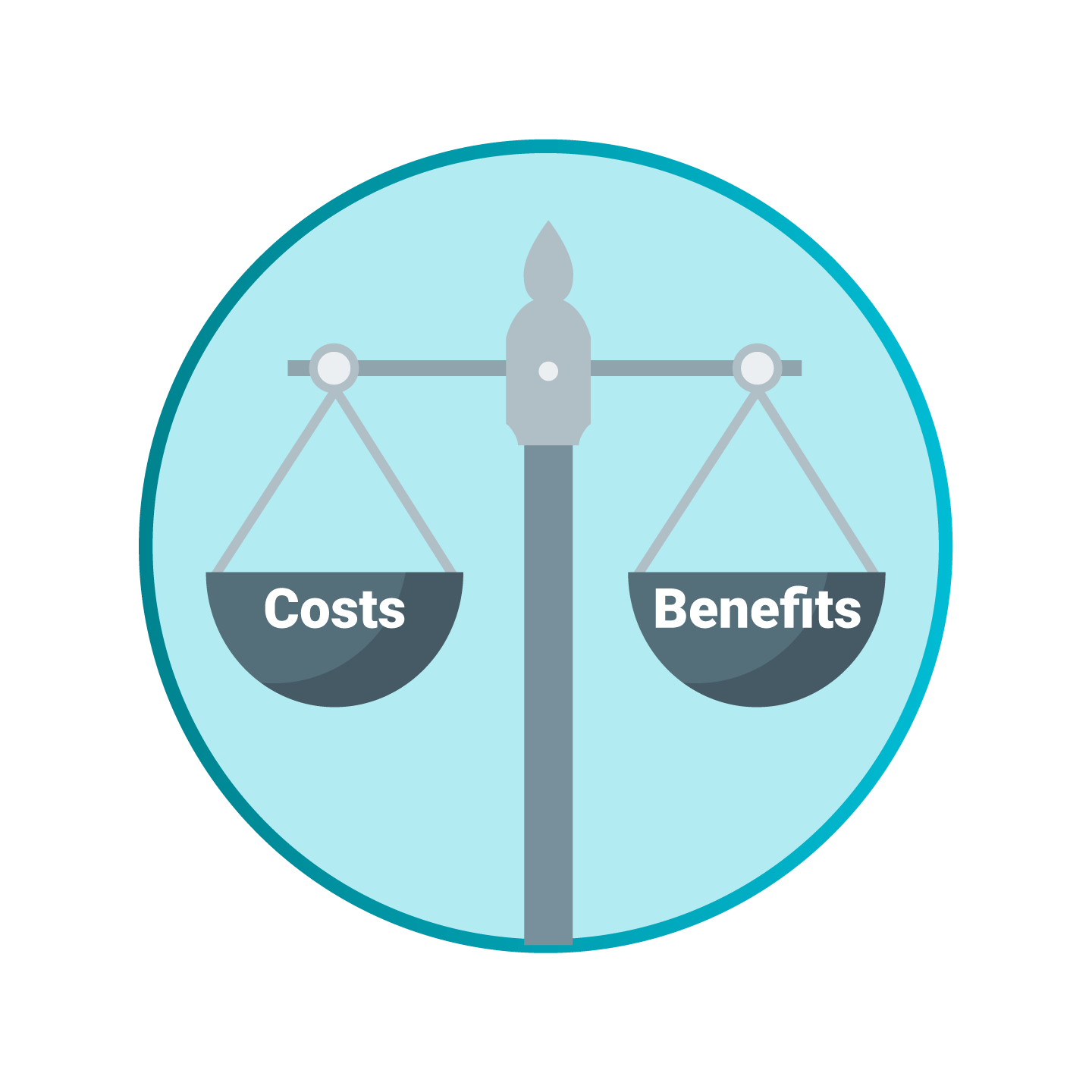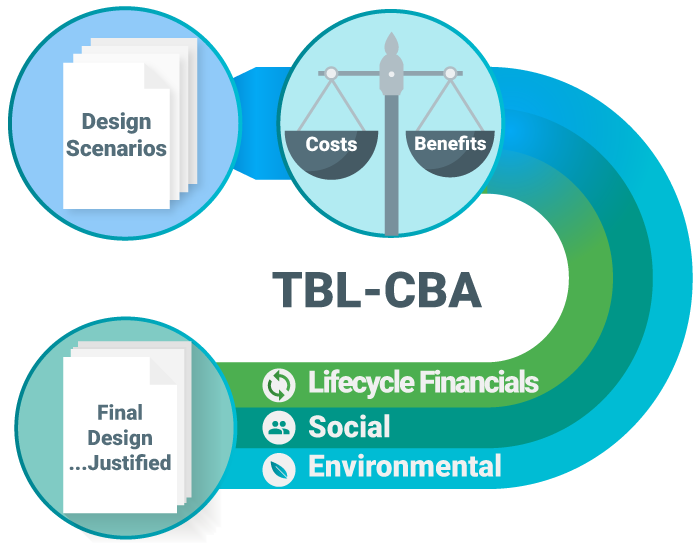
Date: 2025-10-15 Page is: DBtxt003.php txt00013745
Metrics
Triple Bottom Line Cost Benefit Analysis
What is TBL-CBA?
Triple Bottom Line Cost Benefit Analysis
What is TBL-CBA?

Original article:
Peter Burgess COMMENTARY
Peter Burgess
According to Wikipedia, 'Triple Bottom Line Cost Benefit Analysis (TBL-CBA) is an evidenced-based economic method that combines Cost Benefit Analysis (CBA) and Life Cycle Cost Analysis (LCCA) across the triple bottom line (TBL) to weigh costs and benefits to project stakeholders. The TBL-CBA process quantifies total net present value, return on investment, and project payback. TBL-CBA uses location-specific data to give asset owners and design professionals the flexibility and capability to provide a rigorous analysis of investment alternatives through all stages of planning and design.'

What's the bottom line on TBL-CBA?
Triple Bottom Line Cost-Benefit Analysis (TBL-CBA) has historically been very expensive and the realm of specialized expert economists.
We should know.
Our team has a collective 50 years and $50B in applied project experience.
But, as with many emerging concepts, misconceptions and myths arise.
Read our white paper about four of the most common: 4 Myths About TBL-CBA
Triple bottom line cost–benefit analysis
From Wikipedia, the free encyclopedia
This article needs additional citations for verification. Please help improve this article by adding citations to reliable sources. Unsourced material may be challenged and removed.
Find sources: 'Triple bottom line cost–benefit analysis' – news · newspapers · books · scholar · JSTOR (March 2019) (Learn how and when to remove this template message)
Triple bottom line cost-benefit analysis (TBL-CBA) is an evidence-based economic method that combines cost–benefit analysis (CBA) and life-cycle cost analysis (LCCA) across the triple bottom line (TBL) to weigh costs and benefits to project stakeholders. The TBL-CBA process quantifies total net present value, return on investment, and project payback. TBL-CBA uses location-specific data to give asset owners and design professionals the flexibility and capability to provide a rigorous analysis of investment alternatives through all stages of planning and design.
Because it calculates both financial results and monetary values for social and environmental design impacts (valuing what have traditionally been considered intangible benefits such as reduced air pollution or enhanced property values), it provides a common basis for evaluating the entire impact of a project across all social, environmental or ecological, and financial factors.
Origins
TBL-CBA has its origins in cost–benefit analysis, the triple bottom line, and life-cycle cost analysis.
Cost–benefit analysis (CBA)
Cost–benefit analysis (CBA) is a systematic approach to estimating the strengths and weaknesses of alternatives (for example in transactions, activities, functional business requirements); it is used to determine options that provide the best approach to achieve benefits while preserving savings.[1] It calculates the value of various impacts in dollar (or other currency) terms, making it easy to compare like-to-like.
CBA is used extensively by governments to calculate and compare benefits and costs of proposed policies, but can also be used on a design project basis to weigh different design options or justify costs of proposed designs. 'Multiple account cost–benefit analysis' can consider the gains and losses to different stakeholders, thereby allowing the trade-offs among the project's stakeholders to be readily identified and quantified.
CBA is the primary methodology for TBL-CBA and there are many ways of summarizing the results. The best criterion for deciding whether a project can be justified using CBA is a positive net present value (NPV). The NPV is the discounted monetized value of expected net benefits (i.e., benefits minus costs). Other metrics (such as the return on investment, internal rate of return, benefit cost ratio, simple payback period, or discounted payback period) can also be used to summarize the CBA results. CBA has long incorporated the value of externalities such as the willingness to pay for cleaner water or enhanced transit accessibility, but practitioners have differed on the values used despite efforts by national governments to standardize CBA for policy analysis (for example: Australia,[2] Canada,[3] European Union,[4] and the US[5][6][7][8]).
Triple bottom line (TBL)
Triple bottom line (TBL or 3BL) is an accounting framework widely adopted by large organizations since its introduction in 1994 by John Elkington.[9] Organizations can use it to evaluate their performance in a broader perspective to create greater business value[10] or to make decisions on where to allocate resources for the highest organizational return for all key stakeholders.
Triple bottom line (TBL) accounting expands the traditional reporting framework to consider social and environmental performance in addition to financial performance.
Over 7500 organizations report annually their TBL via the Global Reporting Initiative, which is an affiliate of the International Organization for Standardization (ISO), OECD, UN. A growing number of financial institutions incorporate a triple bottom line approach in their work, though often use the term 'environmental, social, and governance' instead of TBL. One example is the CDP network of investors, which represents $100 trillion in assets, and requests data from corporate entities on their climate, water, and other sustainability performance measures on an annual basis.
Life-cycle cost analysis
Life-cycle cost analysis (LCCA) quantifies all the financial costs of a project alternative. The financial costs in LCCA include upfront capital expenditures, ongoing operations and maintenance costs, replacement costs, and the residual value of assets at the end of the life-cycle. The financial costs of each alternative are discounted into present value terms to account for different timing of costs.
TBL-CBA consultants and software
This section contains content that is written like an advertisement. Please help improve it by removing promotional content and inappropriate external links, and by adding encyclopedic content written from a neutral point of view. (March 2019) (Learn how and when to remove this template message) TBL-CBA can be run using web-based software, or commissioned via specialty consultants.
Use
TBL-CBA is seeing an increase use and demand from investors, owners, and rating schemes. For example, TBL-CBA is currently:
- Encouraged by United States Department of Transportation for all FASTLANE and TIGER grant projects[citation needed]
- LEED (by the U.S. Green Building Council) which rewards extra LEED points to projects that run a TBL-CBA.[11]
- Envision (developed by the American Society of Civil Engineers, the American Public Works Association, the American Council of Engineering Companies, and the Zofnass Program at Harvard University's Graduate School of Design) which endorsed TBL-CBA as a compliance path towards Envision certification.[12]
- California's Department of General Services requires use of Autocase by design firms bidding on state building projects.[citation needed]
- A large industrial real estate company Prologis, across its North American facilities.[13]
- Phoenix, Arizona included in its 2017 requests for information: 'looking for a firm with experience in cost–benefit analyses', calling out Autocase as an acceptable means to qualify.[citation needed]
- A large municipal utility, Los Angeles Department of Water and Power, to assess flood reduction design scenarios.[citation needed]
- The US Army and the US Army Corps of Engineers: their 'triple-bottom-line-plus' of sustainability – mission, environment, community and economic benefit.[14]
- MTA NY City Transit's Mother Clara Hale Bus Depot in Harlem, NY opened in November 2014 and has been certified LEED gold level status by the U.S. Green Building Council.[citation needed] MTA NY City Transit and Dewberry used the triple bottom line, a 'proven cost–benefit analysis-based approach'.[15]
- San Francisco International Airport specified TBL-CBA in their 2015 RFP for redevelopment of Terminal 1.[16]
- Employed by 10 of the top 50 design firms per 'Engineering News Record'.[citation needed]
- David, Rodreck; Ngulube, Patrick; Dube, Adock (2013-07-16). 'A cost–benefit analysis of document management strategies used at a financial institution in Zimbabwe: A case study'. SA Journal of Information Management. 15 (2): 10 pages. doi:10.4102/sajim.v15i2.540. ISSN 1560-683X.
- 'Finance Circular 2006/01 | Department of Finance | Department of Finance Archive'. www.finance.gov.au. Retrieved 2017-04-28.
- Secretariat, Treasury Board of Canada. 'Canadian Cost–Benefit Analysis Guide: Regulatory Proposals – Canada.ca'. www.canada.ca. Retrieved 2017-04-28.
- 'Guide to cost–benefit analysis of investment projects'. ec.europa.eu. Retrieved 2017-04-28.
- 'Circular A-4'. The White House. Retrieved 2017-04-28.
- Sunstein, Cass R. (2012-09-12). 'The Stunning Triumph of Cost–Benefit Analysis'. Bloomberg View. Retrieved 2017-04-28.
- '2016 TIGER Benefit–Cost Analysis Guidance'. Department of Transportation. 2016-02-23. Retrieved 2017-04-28.
- 'BCA Resource Guide 2016'. Department of Transportation. 2016-03-03. Retrieved 2017-04-28.
- 'Triple bottom line'. The Economist. 2009-11-17. ISSN 0013-0613. Retrieved 2017-04-28.
- 'The Triple Bottom Line: What Is It and How Does It Work?'. www.ibrc.indiana.edu. Retrieved 2017-04-28.
- 'LEED | U.S. Green Building Council'. www.usgbc.org. Retrieved 2017-05-02.
- 'Introduction to the ISI Envision Rating System (RV-11048AW) | U.S. Green Building Council'. www.usgbc.org. Retrieved 2017-05-02.
- 'Warehousing the world responsibly – because it matters' (PDF). Retrieved 2019-03-21.
- 'Sustainability Overview'. www.usace.army.mil. U.S. Army Corps of Engineers. 2017-11-27. Retrieved 2019-03-21.
- Eget, Steven; Abdallah, Thomas. 'Measuring Sustainability at the Mother Clara Hale Bus Depot' (PDF). www.apta.com/Pages/default.aspx.
- 'San Francisco International Airport recommends Autocase Triple Bottom Line and Cost Benefit Analysis'. Sustainability Solutions. Autodesk – Autocase. Retrieved 2017-04-28.